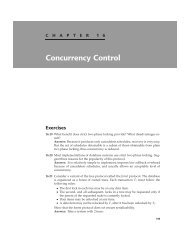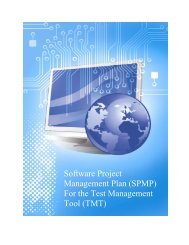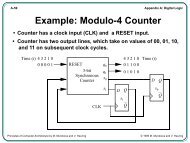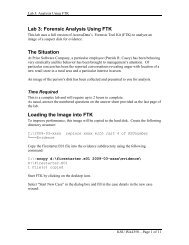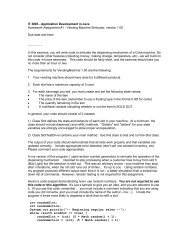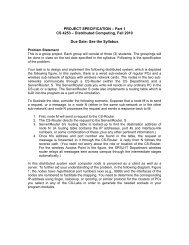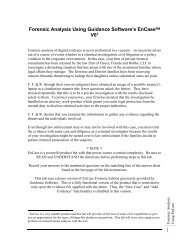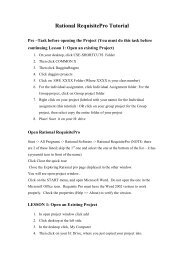You also want an ePaper? Increase the reach of your titles
YUMPU automatically turns print PDFs into web optimized ePapers that Google loves.
1 Installing jGRASP<br />
DRAFT, February 18, 2003, Page 11<br />
Currently, jGRASP is available from http://www.eng.auburn.edu/grasp/ in four versions: two are selfextracting<br />
for Microsoft Windows, one is for Mac OS X, and the fourth is a generic ZIP file. Although the<br />
generic ZIP file can be used to install jGRASP on any system, it is primarily intended for Linux and UNIX<br />
systems. If you are on a Windows machine, either (1) or (2) below is strongly recommended.<br />
(1) jGRASP JRE exe (14.7 MB) – Windows self-extracting exe file with JRE. Since this<br />
includes a copy of the JRE, no Java installation is required to run jGRASP itself; however,<br />
the JRE does not include the Java compiler. If you will be compiling and running Java<br />
programs, you must also install the full J2SDK (also called JDK). This version is convenient<br />
if you will be compiling programs in languages other than Java.<br />
(2) jGRASP exe (2.3 MB) – Windows self-extracting exe file. The full J2SDK must be<br />
installed in order to run jGRASP and to compile and run Java programs.<br />
(3) jGRASP pkg.tar.gz (1.6 MB) – Mac OS X tarred and gzipped package file (requires<br />
admin access to install). J2SDK is preinstalled on Mac OS X machines.<br />
(4) jGRASP (2.1 MB) – Zip file. After unzipping the file, refer to README file for installation<br />
instructions. The full J2SDK must be installed in order to run jGRASP and to compile and<br />
run Java programs.<br />
For Windows 95/98/2000/XP - After downloading (1) or (2) above, simply double click on the .exe file,<br />
and the script will take you through the steps for installing jGRASP. If you are uncertain about a step, you<br />
should accept the default by pressing ENTER. When you have completed the installation, you should<br />
find the jGRASP icon on your desktop. jGRASP should also be listed on the Window’s Start – Programs<br />
menu.<br />
Compilers - Although jGRASP includes settings for a number of popular compilers, it does not include<br />
any compilers. Therefore, if the compiler you need is not already installed on your machine, it must be<br />
installed separately. Since these are generally rather large files, the download time may be quite long. If<br />
a compiler is available to you on a CD (e.g, with a textbook), you may save yourself some time and<br />
energy by installing it from the CD rather than attempting to download it.<br />
jGRASP includes settings for the following languages/compilers. The default compiler settings are<br />
underlined. Note that links for those that can be freely downloaded are included for your convenience.<br />
(1) Ada (GNAT)<br />
ftp://cs.nyu.edu/pub/gnat/3.14p/winnt/(e.g., gnat-3.14p-nt.exe)<br />
(2) C, C++ (GNU/Cygnus, Borland, Microsoft)<br />
http://sources.redhat.com/cygwin/<br />
http://www.borland.com/bcppbuilder/freecompiler/cppc55steps.html<br />
(3) FORTRAN (GNU/Cygnus)<br />
Included with Cygwin, see (2) above. Note that FORTRAN is currently treated as Plain<br />
Text so there is no CSD generation.<br />
(4) Java (J2SDK, Jikes)<br />
http://java.sun.com/j2se/1.4/download.html<br />
(5) Assembler (MASM)<br />
Note that assembler is treated as Plain Text so there is no CSD generation.<br />
After you have installed the compiler(s) of your choice, you will be ready to begin working with jGRASP. If<br />
you are not using the default compiler for a particular language (e.g., J2SDK for Java), you need to<br />
change the Compiler Settings as described below in Compiler Environment Settings.<br />
jGRASP<br />
You can start jGRASP by double clicking on the icon.





